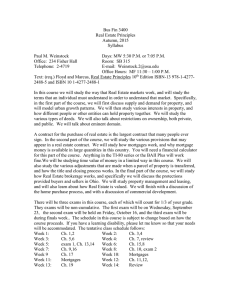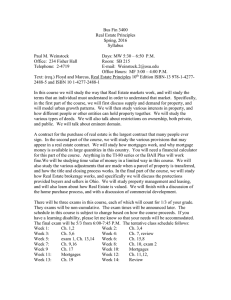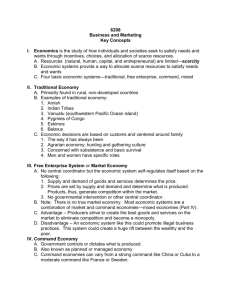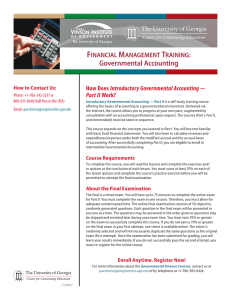Where Are We Going?
advertisement
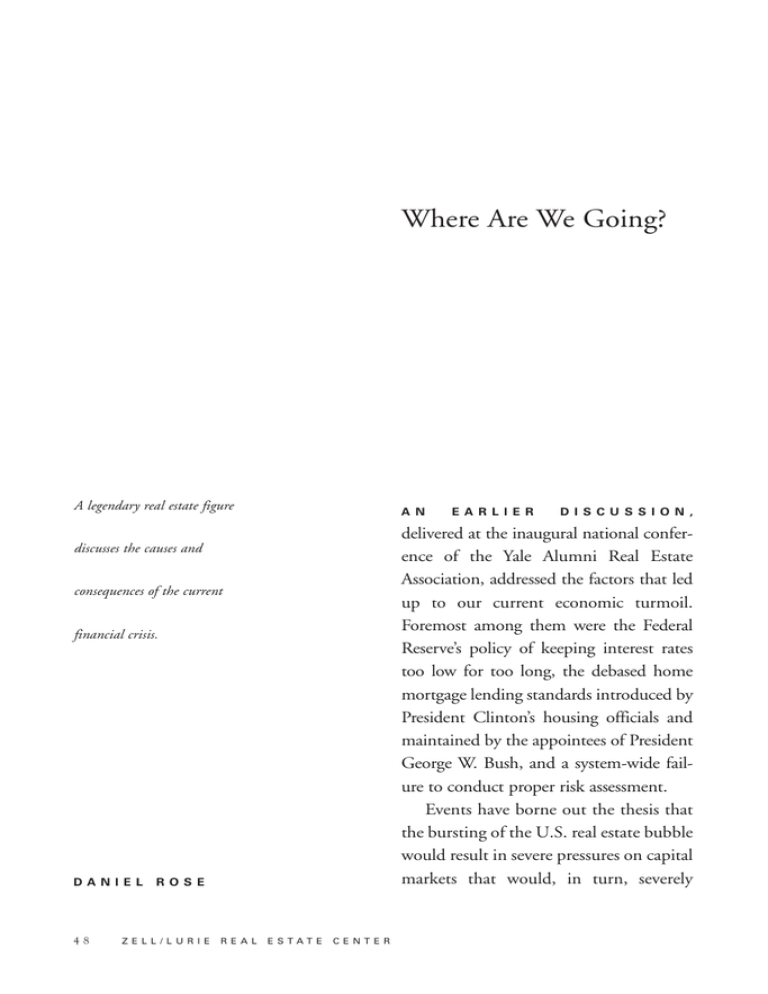
Where Are We Going? A legendary real estate figure A N discusses the causes and consequences of the current financial crisis. DANIEL 48 ROSE ZELL/LURIE REAL E A R L I E R D I S C U S S I O N , delivered at the inaugural national conference of the Yale Alumni Real Estate Association, addressed the factors that led up to our current economic turmoil. Foremost among them were the Federal Reserve’s policy of keeping interest rates too low for too long, the debased home mortgage lending standards introduced by President Clinton’s housing officials and maintained by the appointees of President George W. Bush, and a system-wide failure to conduct proper risk assessment. Events have borne out the thesis that the bursting of the U.S. real estate bubble would result in severe pressures on capital markets that would, in turn, severely ESTATE CENTER weaken financial institutions, which would then affect the “real” economy (employment, consumption, savings, home foreclosures, bankruptcies, and so on). Left unchecked, these reinforcing factors will have serious international repercussions. Concern was expressed about: the high leverage of financial institutions in a period of declining asset value; the large number of AAA-rated loan portfolios consisting of mortgages to borrowers whose incomes were insufficient to cover debt service; the widespread confusion between a “liquidity crisis” and an emerging “solvency crisis;” the fear that a financially exhausted public would be unable to maintain appropriate levels of consumption; and the prospect that inflationary pressures (because of relentlessly increasing international prices of food, fuel and commodities) would preclude the Federal Reserve from applying traditional “cheap money” actions to stimulate the economy. Economic pain was clearly on the horizon, and no governmental quick fix could prevent the turmoil from lasting much longer than Federal Reserve chairman Ben Bernanke’s forecast of an improving 2008 second half and a recovery in 2009. Larry Summers puts it succinctly: “There is a growing consensus that the West is facing the most serious financial crisis since the Second World War.” Is the “end of the world” coming? No. As Adam Smith noted, “A nation has a lot of ruin in it;” an economy can take a lot of pounding and its citizens can absorb a lot of pain yet still function. The U.S. economy has prodigious strengths, and our institutions and people are remarkably resilient. Our housing prices nationwide have already dropped substantially since the high—some 15 percent by some measures—although they still have far to go (perhaps another 10 percent) on the road to market equilibrium. Of the estimated $5 trillion of phony “value” created by the recent bubble, some $2 trillion has already evaporated and perhaps another trillion or so will yet disappear. The bull market in stocks that began in 1983 (when the Dow Jones was at 1,163) continued essentially until October of 2007, when the Dow Jones hit 14,198. No one would claim such an increase reflected only smoke and mirrors, or that, in the inevitable decline, all of the gains would be given back. Our strengths are a given, but our collective failure to anticipate and to forestall the unfolding economic trauma will cause anguish to many. How deep and long-lasting our problems are will depend on our reactions to them. Japan in the 1990s refused to acknowledge or defuse its difficulties, which were also triggered by a real estate crash, and its malaise continues today. U.S. officials were slow to understand REVIEW 49 what was happening, but when, in March of 2008, Bear Stearns notified the Federal Reserve on a Friday of its impending bankruptcy, our Fed and Treasury leaders worked throughout the weekend to arrange a buy-out of Bear Stearns by JPMorgan Chase. The “weekend improvisation” involved the Fed intervening with public money for a non-bank financial institution for the first time since the Great Depression. By definition, when an action is unprecedented, it establishes a new precedent; and “moral hazard” is a legitimate fear. For example, Alan Greenspan has recently said, “There is no credible argument for bailing out Bear Stearns and not government-sponsored enterprises like Fannie Mae and Freddie Mac.” Chairman Bernanke, who told a banking conference in June 2007 in South Africa that “the troubles in the subprime sector seem unlikely to seriously spill over to the broader economy,” moved nine months later to forestall the failure of Bear Stearns, which could have created an international financial catastrophe. Fortunately, Bernanke remembered the failure of Austria’s bank Creditanstalt and its role in the Great Depression. U.S. consumer confidence is at its lowest level in thirty years; an estimated ten million U.S. families have negative equity in their homes. Home foreclosures, auto loan and credit card defaults, and bank failures are at frightening levels, and the 50 ZELL/LURIE REAL ESTATE CENTER Federal Deposit Insurance Corp. is at its most over-extended position since its creation in 1933. Sophisticated observers are convinced that after the November 2008 elections, the National Bureau of Economic Research will confirm the recession that many already see. Will the recovery pattern be in the shape of a U, an L or a W? Only a few Panglossians have hope of a quick V-shaped recovery. Nobel laureate Joseph Stieglitz recently said, “There is an increasing consensus that the downturn will be prolonged and widespread.” What is to be done? The answers involve six separate areas: short-term governmental actions; medium-term to long-term governmental actions; financial institution regulation; governmental housing policy; and bursting bubbles. G OV E R N M E N TA L RESPONSES A U.S. public with little personal savings, seriously declining home values, heavy credit card and auto loan debt, and increasing fear of unemployment is unlikely to spend cash grants from the government. That is why the $168 billion government stimulus program had so little impact, with only 10 percent to 20 percent of the rebate cash being spent, and the rest going into savings or debt reduction. Had that same money been allocated to states and municipalities for immediate expenditure on mothballed infrastructure projects, not only would the economic stimulus impact have been greater, but instead of more garden furniture, cosmetics and sports equipment, we would have had improved roads, bridges, water levees, airports and so forth to show for the money. The U.S. economy (public and private) has focused on borrowing and consumption rather than on savings, investment, and production. This is not sustainable, and the sooner we face that fact, the less painful the transition will be. To generate major economic activity in the medium and long term, we must turn to “infrastructure” and “alternative energy sources.” This means massive governmental expenditures to maintain, restore, improve and create the public physical facilities that underpin our national well-being. The U.S. Department of Transportation estimates that every $1 billion in highway investment creates 47,500 new jobs and generates more than $2 billion in economic activity. Highways, bridges, dams, airports, harbors, water levees, mass-transit programs, new energy facilities of various kinds—public investment in all of them is needed to stimulate the economy and improve our quality of life. According to the Federal Highway Administration, of the nation’s 600,000 bridges, a quarter are in below-acceptable state. The American Society of Civil Engineers has put price tags on the necessary repair bills (they are staggering) but points out that America today invests only 2.4 percent of our GNP in infrastructure, compared with Europe’s 5 percent and China’s 9 percent. Given our clogged ports (such as Los Angeles or New York), our growing airline flight delays that cost at least $15 billion each year in lost productivity, and the hours wasted in rush hour commuting, public support for infrastructure programs should be enthusiastic. Congestion on roads costs $78 billion annually, in the form of 4.2 billion lost hours and 2.9 billion wasted gallons of gasoline, according to the Texas Transportation Institute. Historically, we have clear precedent, from Thomas Jefferson’s support for canals and roads in the nineteenth century, to Dwight Eisenhower’s Highway Act, which created the interstate system, in the twentieth. But while the rest of the advanced world is building high-speed trains, our only version runs between Boston and Washington on an outdated and inadequate track. The case for investment in alternate energy sources needs little comment. The U.S. consumes one quarter of the world’s oil while possessing less than 3 percent of its oil reserves; we spend $700 billion to $800 billion a year importing the difference. Cutting consumption and produc- REVIEW 51 ing alternative sources of energy like solar, wind, hydroelectricity, and biofuels are no longer optional but mandatory actions. Seventy-seven percent of France’s electricity today comes from nuclear power, and the United States must rethink the nuclear question. Infrastructure spending and alternative energy spending can supplement consumer spending in the short to medium term as engines for economic growth. In the long term, our helping to meet the consumer needs of the growing Chinese and Indian middle classes will keep our economic engines running. In the United States, personal consumption constitutes 70 percent of GNP; in China it is below 40 percent, but in time it will steadily rise, too. That helps. When the Chinese buy more cosmetics, for example, they will probably buy more American brands like Estee Lauder. R E G U L AT I O N The U.S. financial and economic system has demonstrated its dynamism, creativity, and flexibility. To continue to function well, however, it requires public support and participation that are only gained by embracing more vigorously than ever the concepts of disclosure, transparency, accountability, and fairness. The investing public has little idea of its exposure to risk because of institutional “off balance sheet” 52 ZELL/LURIE REAL ESTATE CENTER transactions and the degree of leverage prevalent in the financial community. The public has little comprehension of the risk exposures of the complex derivative instruments it owns, directly or indirectly, and it understands little about the workings of the popular hedge funds. Our governmental officials have been remiss in permitting such opaqueness throughout our financial system. Fresh regulations are overdue in balance sheet and risk disclosure, required liquidity, and capital-to-loan ratios; we need more effective disclosure rules about self-dealing and short-selling. Governmental regulation of non-banking institutions is now “frontburner,” since the “too big to fail” premise implies possible governmental bailouts, and bailout responsibilities require appropriate regulation. An alternative, of course, is to not let institutions get “too big.” Hence, giant entities like UBS and Citigroup are considering restructuring. Creative destruction, the great insight of Joseph Schumpeter, should not be forgotten. Recessions—and the financial failures and bankruptcies that follow—are part of the mechanics by which our free market system cleanses and revives itself. Direct governmental intervention should be rare, and used only where the broad public interest is the over-riding consideration. Financial penalties and loss for the shareholders and company officers should be mandatory before bailouts. And inter- vention must require appropriate “pay back” provisions for the return of public funds on the model of the Resolution Trust Corporation of the 1990s. Fannie Mae and Freddie Mac shareholders and officers, who have made fortunes over the years, should not benefit from government bailouts, and public policy should be firmly against “private benefit, public loss.” One important problem to be faced is the disparity in accounting standards, disclosure, and trading practices around the world. Financial globalization will demand accounting standardization, and appropriate solutions are long overdue. The AAA bond ratings given to toxic subprime mortgage packages should excite greater outrage. Only after unwary lenders suffered severe losses from reliance on defective ratings did the Security and Exchange Commission (SEC) take notice. In July 2008, the SEC released a scathing thirty-seven-page report charging that major rating firms, including Fitch, Moody’s and Standard and Poor’s, flouted conflict-of-interest guidelines and considered their own profits when rating securities at levels far higher than true risk exposure justified. “Who shall guard the guardians?” asked the ancient Romans. Unfortunately, there is no easy answer. Individuals of character and professional expertise (Paul Volcker and Gerald Corrigan come to mind) should be impaneled to develop recommendations for change that do not stifle the financial industry, yet protect the public. The false belief that housing values must invariably rise underlay 100-percent LTV home mortgages to borrowers whose income was insufficient to cover debt service. With the encouragement of the Clinton and G.W. Bush administrations, the percentage of U.S. families owning homes rose to nearly 70 percent from the traditional 62 percent to 64 percent. When the housing bubble burst, some 10,000,000 families found the equity value of their homes was negative. The majority of those homes had mortgages written in 2005 to 2007, with little or no down payment required, with unverified borrowers’ income, and with “teaser” interest rates that were not sustainable. Under HUD’s prodding, Fannie Mae went from $1.2 billion in subprime mortgages and security purchases in 2000, to $9.2 billion in 2001, and $15 billion in 2002. In 2003 alone, Freddie Mac and Fannie Mae bought $81 billion in subprime mortgages. Between 2004 and 2006, these two government-sponsored enterprises bought $434 billion in securities backed by subprime loans. Now that the chickens have come home to roost, we must realize that not everyone can afford to own a home and that renting is not a bad thing. It is instructive to note that Canada, which requires substantial down payments from mortgage borrowers and REVIEW 53 solid indications that borrowers can pay debt service, has had no subprime debacle threatening its economy. Denmark requires that mortgages remain on the balance sheets of the issuers, eliminating the moral hazard of selling off the risks to others. When your money is at risk, you tend to be more careful. CONCLUSION Thirty-five years ago an economist named Hyman Minsky, who believed that free markets are inherently unstable and crisis-prone, described five stages of a credit cycle: displacement, boom, euphoria, profit-taking and panic. Minsky, his disciple Charles Kindleberger (author of Manias, Panics and Crashes: A History of Financial Crises), and Kindleberger’s disciple, Yale professor Robert J. Shiller (author of Irrational Exuberance) all grasp the role of emotion and psychology in economic decision-making, unlike the conventional wisdom that maintains that economic decision-making is rational, markets are efficient—and there really is a Tooth Fairy. Those wanting to understand how our system operates should be familiar with concepts like “discounted future value,” “price elasticity,” “bond yield curves,” and the like. But they should also be familiar with the works of Minsky, 54 ZELL/LURIE REAL ESTATE CENTER Kindleberger, Schiller, and their predecessor, Charles Mackay, author of the classic Extraordinary Popular Delusions and the Madness of Crowds. The American model of a competitive, free-market, loosely-regulated economy has demonstrated to the world how well it can stimulate and harness the energy and creativity of a dynamic public. The tightly controlled, centrally controlled economies of Joseph Stalin and Mao Tse-Tung failed by comparison and are now, in Leon Trotsky’s phrase, “in the dustbin of history.” An exploding Chinese economy, however, indicates that in the twenty-first century we may see competition between “democratic capitalism” in the West and “autocratic capitalism” in the East. Over time, each of these pragmatic societies may take on some of the trappings of the other, with more individualism, privacy, and free choice in the East and more large-scale governmental intervention in the West. How will the game play out? As Chou En Lai said in the 1960s of the impact of the French Revolution, “It’s too soon to tell.”
